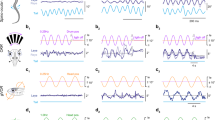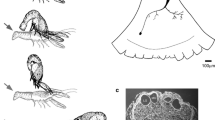Summary
-
1.
When Xenopus laevis embryos swim into an obstruction they usually stop. This stopping response to stimulation on the head is present from stage 28 to 45. At stage 37/38 it is more reliable in restrained than in free-swimming animals, and to stimuli to the cement gland than to the head skin. ‘Fictive’ swimming also stops reliably after the same stimuli but struggling and ‘fictive’ struggling do not.
-
2.
Discharge of deformation-sensitive trigeminal sensory neurons in response to pressure on the cement gland or head skin precedes the ‘fictive’ stopping response. When the embryo hangs from cement gland mucus, trigeminal neurons are active and the embryo is less responsive to stimulation.
-
3.
Lesions of the central nervous system have allowed us to draw the following conclusions about this inhibitory pathway: (a) either the cement gland or the head skin must be intact; (b) one trigeminal ganglion is both sufficient and necessary; (c) the pathway is independent of the forebrain and midbrain; (d) it can take an ipsilateral or contralateral route through the hindbrain; (e) at least two hindbrain interneuron components are involved.
-
4.
A similar stopping response is present in embryos and larvae of the urodele Ambystoma mexicanum.
Similar content being viewed by others
Abbreviations
- CNS :
-
central nervous system
- GABA :
-
gamma amino butyric acid
- HRP :
-
horseradish peroxidase
References
Arshavsky YuI, Beloozerova IN, Orlovsky GN, Panchin YuV, Pavlova GA (1985) Control of locomotion in marine mollusc Clione limacina. I. Efferent activity during actual fictitious swimming. Exp Brain Res 58:255–262
Boothby KM (1988) Termination of swimming activity in the Xenopus laevis embryo via a descending GABAergic pathway. Neurosci Lett 32:S19
Boothby KM, Roberts A (1988) Descending GABA neurones inhibit swimming in the amphibian embryo, Xenopus laevis. J Physiol (Lond) 401:38P
Chadwick LE (1953) The flight muscles and their control. In: Roeder KD (ed) Insect physiology. Wiley, New York, pp 637–648
Dale N, Ottersen OP, Roberts A, Storm-Mathisen J (1986) Inhibitory neurones of a motor pattern generator in Xenopus revealed by antibodies to glycine. Nature (Lond) 324:255–257
Davies SN, Kitson DL, Roberts A (1982) The development of the peripheral trigeminal innervation in Xenopus embryos. J Embryol Exp Morph 70:215–224
Dingle H (1961) Flight and swimming reflexes in giant water bugs. Biol Bull 121:117–128
Fraenkel G (1932) Untersuchungen über die Koordination von Reflexen und automatisch-nervösen Rhythmen bei Insekten. I. Die Flugreflexe der Insekten und ihre Koordination. Z Vergl Physiol 16:371–393
Gray J (1968) Animal locomotion. Weidenfeld and Nicolson, London
Gray J, Sand A (1936) The locomotory rhythm of the dogfish. J Exp Biol 13:200–209
Gray J, Lissmann HW, Pumphrey RJ (1938) The mechanism of locomotion in the leech (Hirudo medicinalis Ray). J Exp Biol 15:408–430
Hayes BP, Roberts A (1983) The anatomy of two functional types of mechanoreceptive ‘free’ nerve ending in the head skin of Xenopus embryos. Proc R Soc Lond B 218:61–76
Holstege JC (1991) Ultrastructural evidence for GABAergic brainstem projections to spinal motoneurons in the rat. J Neurosci 11:159–167
Kahn JA, Roberts A (1982) Experiments on the central pattern generator for swimming in amphibian embryos. Phil Trans R Soc Lond B 296:229–243
Lissmann HW (1947) The neurological basis of the locomotory rhythm in the spinal dogfish. I. Reflex behaviour. J Exp Biol 23:143–161
Muntz L (1964) Neuro-muscular foundations of behaviour in embryonic and larval stages of the Anuran, Xenopus laevis. Ph. D. dissertation, Univ. of Bristol
Nieuwkoop PD, Faber J (1956) Normal tables of Xenopus laevis (Daudin). North Holland Publishing Co., Amsterdam
Nordlander RH, Baden ST, Ryba TMJ (1985) Development of early brainstem projections to the tail spinal cord of Xenopus. J Comp Neurol 231:519–529
Pringle JWS (1974) Locomotion: flight. In: Rockstein M (ed) The physiology of the Insecta. Vol. III. Academic Press, London, pp 433–476
Roberts A (1980) The function and role of two types of mechanoreceptive ‘free’ nerve endings in the head skin of amphibian embryos. J Comp Physiol 135:341–348
Roberts A (1989) The neurons that control axial movements in a frog embryo. Amer Zool 29:53–63
Roberts A, Blight AR (1975) Anatomy, physiology and behavioural role of sensory nerve endings in cement gland of embryonic Xenopus. Proc R Soc Lond B 192:111–127
Roberts A, Clarke JDW (1982) The neuroanatomy of an amphibian embryo spinal cord. Phil Trans R Soc Lond B 296:195–212
Roberts A, Sillar KT (1990) Characterisation and function of spinal excitatory interneurons with commissural projections in Xenopus laevis embryos. Europ J Neurosci 2:1051–1062
Roberts A, Dale N, Ottersen OP, Storm-Mathisen J (1987) The early development of neurons with GABA immunoreactivity in the CNS of Xenopus laevis embryos. J Comp Neurol 261:435–449
Satterlie RA, LaBarbera M, Spencer AN (1985) Swimming in the pteropod mollusc, Clione limacina. I. Behaviour and morphology. J Exp Biol 116:189–204
Schreckenberg GM, Jacobson AB (1975) Normal stages of development of the axolotl, Ambystoma mexicanum. Dev Biol 42:39–140
Sillar KT, Roberts A (1988a) A neuronal mechanism for sensory gating during locomotion in a vertebrate. Nature (Lond) 331: 262–265
Sillar KT, Roberts A (1988b) Unmyelinated cutaneous afferent neurons activate two types of excitatory amino acid receptor in the spinal cord of Xenopus laevis embryos. J Neurosci 8:1350–1360
van Mier P (1986) The development of the motor system in the clawed toad, Xenopus laevis. Ph. D. thesis, Univ. of Nijmegen
vanMier P, tenDonkelaar HJ (1984) Early development of descending pathways from the brain stem to the spinal cord in Xenopus laevis. Anat Embryol 170:295–306
vanMier P, Armstrong PJ, Roberts A (1989) The early development of locomotion in Xenopus laevis. Neuroscience pp 32:113–126
vonSeckendorff Hoff K, Wassersug RJ (1986) The kinematics of swimming in larvae of the clawed frog, Xenopus laevis. J Exp Biol 122:1–12
Weevers R de G (1971) A preparation of Aplysia fasciata for intrasomatic recording and stimulation of single neurones during locomotor movements. J Exp Biol 54:659–677
Author information
Authors and Affiliations
Rights and permissions
About this article
Cite this article
Boothby, K.M., Roberts, A. The stopping response of Xenopus laevis embryos: behaviour, development and physiology. J Comp Physiol A 170, 171–180 (1992). https://doi.org/10.1007/BF00196899
Accepted:
Issue Date:
DOI: https://doi.org/10.1007/BF00196899




